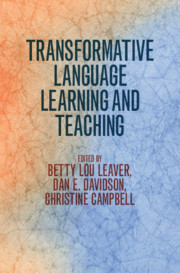Book contents
- Transformative Language Learning and Teaching
- Transformative Language Learning and Teaching
- Copyright page
- Contents
- Figures
- Tables
- Contributors
- Foreword
- Acknowledgments
- Abbreviations
- 1 Introduction
- Part I Theoretical Framework
- Part II Transformative Language Learning and Teaching Applications in Government Programs
- Part III Transformative Language Learning and Teaching Applications in University Programs
- Part IV Transformative Language Learning and Teaching Applications in Immersion Programs
- Part V The Learner
- Part VI Faculty Development
- Part VII Assessment
- 23 Identifying and Evaluating Transformative Learning in the Language Classroom
- 24 Testing and Transformative Language Learning
- 25 Assessing Students in a Transformative Learning Program
- References
- Index
23 - Identifying and Evaluating Transformative Learning in the Language Classroom
from Part VII - Assessment
Published online by Cambridge University Press: 26 January 2021
- Transformative Language Learning and Teaching
- Transformative Language Learning and Teaching
- Copyright page
- Contents
- Figures
- Tables
- Contributors
- Foreword
- Acknowledgments
- Abbreviations
- 1 Introduction
- Part I Theoretical Framework
- Part II Transformative Language Learning and Teaching Applications in Government Programs
- Part III Transformative Language Learning and Teaching Applications in University Programs
- Part IV Transformative Language Learning and Teaching Applications in Immersion Programs
- Part V The Learner
- Part VI Faculty Development
- Part VII Assessment
- 23 Identifying and Evaluating Transformative Learning in the Language Classroom
- 24 Testing and Transformative Language Learning
- 25 Assessing Students in a Transformative Learning Program
- References
- Index
Summary
Over the past 15 years, the adult model of transformative learning has gained attention among language educators for its ability to explain moments of perspective-shifting, a process that involves deep, conscious decentering of the self from existing beliefs and values. Given that transformative learning represents a highly individual experience requiring effort on the part of the individual to engage critically with one's own assumptions as they pertain to particular experiences, such learning cannot be guaranteed, but can be fostered in instructional contexts. Indeed, scholars have noted the inherent challenge in evaluating transformative learning, suggesting that process rather than product should be the focus of assessment. This chapter explores how the transformative pedagogical tool of written structured reflection can be used by language instructors to identify moments of perspective-shifting among their learners and understand the crucial skills that underlie the ability to transform one's meaning perspective. Examples from beginning L2 learner reflections illustrate what success can look like in a transformative learning assessment framework.
Keywords
- Type
- Chapter
- Information
- Transformative Language Learning and Teaching , pp. 217 - 226Publisher: Cambridge University PressPrint publication year: 2021

